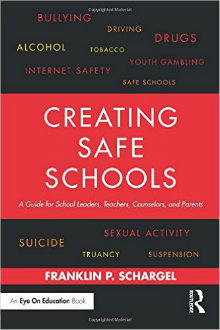Creating Safe Schools: Theory vs. Reality
Creating Safe Schools: A Guide for School Leaders, Teachers, Counselors, and Parents
By Franklin P. Schargel
(Routledge/Eye on Education, 2014 – Learn more)

Safe schools are a right, yet these precious institutions are vulnerable. I guarantee that if you take Franklin P. Schargel’s 20-question introductory quiz on violence prevention, you will learn something.
But what you learn will lead to more questions. For example, “Schools are safer” today, but data is five years old, so is this still true? What’s most important is society’s perception that they are more dangerous due to real-life events.

When I became principal in a poverty area, I was appalled at the casualness toward schoolwide student safety. And although Schargel believes everyone has to be involved in ensuring safety, what do you do when to save money school psychologists and counselors are few and not all schools have this support, or even co-administrators, such as vice-principals? In other words, there are places where the resources Schargel wants us to gather are limited by political and economic decisions beyond our control.
For these reasons, I was hoping for more specific advice of what to do when the unthinkable happens rather than advice on preventing student drug abuse, teen driving accidents, pregnancies, truancy, and youth gambling, subjects for which there are numerous other books.
Although Schargel does talk about “Making an Emergency Preparedness Plan,” I would have liked to have seen a model school plan or two for lockdowns or evacuations to “sister” schools, ways to comfort students and how to discuss or have them write about violence, or even a process to get students to restrooms during an all-day lockdown.
That doesn’t mean there isn’t plenty to value in the book. I would use many of his checklists beginning with his school bus rules, although he assumes that students have assigned seats, which isn’t always true and isn’t always up to the school but the district. I would also use “Internet Safety Guidelines for Students” and make sure students and their parents are familiar with them and have discussed them by having both students and teachers sign.
Violent school incidents
Chapter six is a separate chapter on “Violent School Incidents.” Schargel mentions that an Arkansas district arms teachers and staff, but makes no value judgments. He also talks about gang violence but doesn’t mention how parents in some areas are also members of gangs and can cause school problems.
To prevent school violence he suggests providing a “school resource officer” from the local police force. This is not likely to happen in most districts, so how else can we build a relationship with police? “Peer mediation” is good advice, but how should administrators set up such a program on the elementary and/or secondary level? I would have to read another book to help me implement some recommendations.
Schargel ends this list with “Be aware that no matter what you do, things will happen.” This is not comforting and the caveat, “So be vigilant, always,” is needed, especially since he says, “Those who fail to recognize and stop school violence as it occurs actually promote violence…”
He suggests “increased supervision” in hot spots, but if teachers aren’t on board because their union contract says they don’t have to supervise, and there is no money to pay benefits of aides beyond a certain number of work hours each day, then there’s a bigger problem.
Schargel tells parents, “you may need to seek an attorney’s help” if bullying persists, but few parents have the time or means to do this and are counting on the school and new laws in most states that tell school personnel that they must deal with bullies.
To get kids out of gangs he suggests sports teams or after-school events. Good ideas. When I implemented a basketball team, I had fewer discipline problems because the students loved the team and the coach and competing. They did not want to be excluded from the team.
I like that Schargel includes the children as having a responsibility in keeping their school safe. They should feel they can approach adults if something is wrong. He mentions that they also need to be informed of “the plan” in case of a school or national crisis.
Truancy and suspension
Chapter nine is entitled “Truancy and Suspension,” and I see them as two separate issues. Administrators’ hands are often tied today when it comes to suspending kids, yet most administrators I know only suspend for the most violent acts or for a cooling off period and for the safety of the other students who may need a breather from a student involved in an escalating pattern of violence.
When it comes to truancy, I have heard all of the excuses the author lists that parents give. He advises, “…take steps to avoid children and their parents from using these excuses.” Although he does recommend linking truancy to grades, if the student makes up tests and quizzes and passes them, then what? Linking truancy to getting a driver’s license may help, but needs community support. Saturday School is a good suggestion, but administrators or teachers have to be paid.
Schargel’s recommendation to parents of truants requires a separate book: “Schools need to change…A stronger focus on retaining staff, cutting down on staff absences, developing appropriate curriculum, teaching styles and school ethos is needed. Very persistent truants might benefit from alternatives to school.”
In Schargel’s conclusion he advocates gun control in America. I wish he had also addressed the problem of pellet guns made to look like real guns. He admits that while events like the massacre at Sandy Hook Elementary have happened, he maintains that “schools are still safer than the streets and even still safer than students’ homes.”
Sadly, I am not convinced. I will use his extensive lists of resources at the end of the book for further study.
Dr. Mary Langer Thompson, a retired secondary English teacher and elementary principal, is a published poet and author who now writes full time.


































